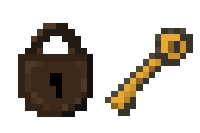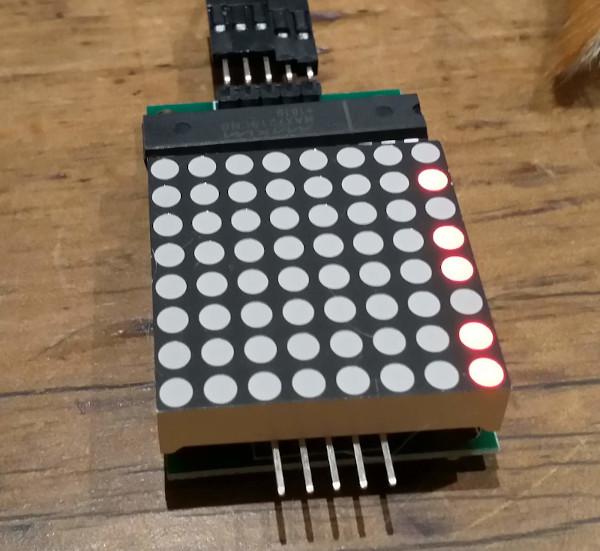|
"""
|
|
A port of the MaxMatrix LED library to python for use with FirmataPlus.
|
|
"""
|
|
from pymata_aio.pymata3 import PyMata3 # type: ignore
|
|
from pymata_aio.constants import Constants # type: ignore
|
|
|
|
from PIL import Image
|
|
|
|
MAX7219_REG_NOOP = 0x00
|
|
MAX7219_REG_DIGIT0 = 0x01
|
|
MAX7219_REG_DIGIT1 = 0x02
|
|
MAX7219_REG_DIGIT2 = 0x03
|
|
MAX7219_REG_DIGIT3 = 0x04
|
|
MAX7219_REG_DIGIT4 = 0x05
|
|
MAX7219_REG_DIGIT5 = 0x06
|
|
MAX7219_REG_DIGIT6 = 0x07
|
|
MAX7219_REG_DIGIT7 = 0x08
|
|
MAX7219_REG_DECODEMODE = 0x09
|
|
MAX7219_REG_INTENSITY = 0x0a
|
|
MAX7219_REG_SCANLIMIT = 0x0b
|
|
MAX7219_REG_SHUTDOWN = 0x0c
|
|
MAX7219_REG_DISPLAYTEST = 0x0f
|
|
|
|
LOW, HIGH = 0, 1
|
|
LSBFIRST, MSBFIRST = 0, 1
|
|
|
|
# Following bit shifting functons adapted from https://wiki.python.org/moin/BitManipulation
|
|
|
|
|
|
def test_bit(value: int, offset: int) -> int:
|
|
" Returns a 1, if the bit at 'offset' is one, else 0"
|
|
mask = 1 << offset
|
|
return 1 if (value & mask) else 0
|
|
|
|
|
|
def set_bit(value: int, offset: int) -> int:
|
|
" Returns an integer with the bit at 'offset' set to 1"
|
|
mask = 1 << offset
|
|
return (value | mask)
|
|
|
|
|
|
def clear_bit(value: int, offset: int) -> int:
|
|
" Returns an integer with the bit at 'offset' cleared "
|
|
mask = ~(1 << offset)
|
|
return (value & mask)
|
|
|
|
|
|
def toggle_bit(value: int, offset: int) -> int:
|
|
" Returns an integer with the bit at 'offset' inverted, 0 -> 1 and 1 -> 0 "
|
|
mask = 1 << offset
|
|
return (value ^ mask)
|
|
|
|
|
|
def write_bit(value: int, offset: int, bit: int) -> int:
|
|
if bit == HIGH:
|
|
return set_bit(value, offset)
|
|
elif bit == LOW:
|
|
return clear_bit(value, offset)
|
|
else:
|
|
raise Exception("bit must be high or low")
|
|
|
|
|
|
class MaxMatrix:
|
|
|
|
def __init__(self, board, data_pin: int, load_pin: int, clock_pin: int):
|
|
self.board = board
|
|
self.data_pin = data_pin
|
|
self.load_pin = load_pin
|
|
self.clock_pin = clock_pin
|
|
self.buffer = bytearray(80)
|
|
|
|
# initialise the LED display
|
|
self.board.set_pin_mode(self.data_pin, Constants.OUTPUT)
|
|
self.board.set_pin_mode(self.clock_pin, Constants.OUTPUT)
|
|
self.board.set_pin_mode(self.load_pin, Constants.OUTPUT)
|
|
|
|
self.board.digital_write(self.clock_pin, HIGH)
|
|
|
|
self.set_command(MAX7219_REG_SCANLIMIT, 0x07)
|
|
self.set_command(MAX7219_REG_DECODEMODE, 0x00) # using an led matrix (not digits)
|
|
self.set_command(MAX7219_REG_SHUTDOWN, 0x01) # not in shutdown mode
|
|
self.set_command(MAX7219_REG_DISPLAYTEST, 0x00) # no display test
|
|
|
|
# empty registers, turn all LEDs off
|
|
self.clear()
|
|
self.set_intensity(0x0f) # the first 0x0f is the value you can set
|
|
|
|
def reload(self) -> None:
|
|
for col in range(8):
|
|
self.board.digital_write(self.load_pin, LOW)
|
|
self.shift_out(col + 1)
|
|
self.shift_out(self.buffer[col])
|
|
self.board.digital_write(self.load_pin, LOW)
|
|
self.board.digital_write(self.load_pin, HIGH)
|
|
|
|
def clear(self):
|
|
self.buffer = bytearray(80)
|
|
self.reload()
|
|
|
|
def set_command(self, command: int, value: int):
|
|
self.board.digital_write(self.load_pin, LOW)
|
|
|
|
self.shift_out(command)
|
|
self.shift_out(value)
|
|
|
|
self.board.digital_write(self.load_pin, LOW)
|
|
self.board.digital_write(self.load_pin, HIGH)
|
|
|
|
def shift_out(self, value: int, bit_order: int=MSBFIRST):
|
|
# Adapted from hardware/arduino/avr/cores/arduino/wiring_shift.c
|
|
for i in range(8):
|
|
if bit_order == LSBFIRST:
|
|
b = HIGH if ~~(value & (1 << i)) else LOW
|
|
else:
|
|
b = HIGH if ~~(value & (1 << (7 - i))) else LOW
|
|
self.board.digital_write(self.data_pin, b)
|
|
self.board.digital_write(self.clock_pin, HIGH)
|
|
self.board.digital_write(self.clock_pin, LOW)
|
|
|
|
def set_intensity(self, intensity: int):
|
|
self.set_command(MAX7219_REG_INTENSITY, intensity)
|
|
|
|
def set_column(self, col: int, value: int):
|
|
"""
|
|
set the column to the value, for example:
|
|
>>> mm.set_column(0, 0b11011001)
|
|
"""
|
|
self.board.digital_write(self.load_pin, LOW)
|
|
self.shift_out(col + 1)
|
|
self.shift_out(value)
|
|
self.board.digital_write(self.load_pin, LOW)
|
|
self.board.digital_write(self.load_pin, HIGH)
|
|
self.buffer[col] = value
|
|
|
|
def set_row(self, row: int, value: int):
|
|
"""
|
|
set the row to the value, for example:
|
|
>>> mm.set_row(0, 0b11011001)
|
|
"""
|
|
for i in range(8):
|
|
b = test_bit(value, i)
|
|
self.buffer[i] = write_bit(self.buffer[i], row, b)
|
|
self.reload()
|
|
|
|
def set_dot(self, col: int, row: int, value: int):
|
|
self.buffer[col] = write_bit(self.buffer[col], row, value)
|
|
self.board.digital_write(self.load_pin, LOW)
|
|
self.shift_out(col + 1)
|
|
self.shift_out(self.buffer[col])
|
|
self.board.digital_write(self.load_pin, LOW)
|
|
self.board.digital_write(self.load_pin, HIGH)
|
|
|
|
def shift_left(self, fill_zero: bool = False):
|
|
if fill_zero:
|
|
self.buffer = self.buffer[-1:] + bytearray(1)
|
|
else:
|
|
self.buffer = self.buffer[-1:] + self.buffer[:-1]
|
|
self.reload()
|
|
|
|
def shift_right(self, fill_zero: bool = False):
|
|
if fill_zero:
|
|
self.buffer = self.buffer[1:] + bytearray(1)
|
|
else:
|
|
self.buffer = self.buffer[1:] + self.buffer[:1]
|
|
self.reload()
|
|
|
|
def shift_up(self, fill_zero: bool = False):
|
|
for i in range(len(self.buffer)):
|
|
if fill_zero:
|
|
self.buffer[i] = self.buffer[i] << 1
|
|
else:
|
|
self.buffer[i] = ((self.buffer[i] << 1) & 0xff) | test_bit(self.buffer[i], 7)
|
|
self.reload()
|
|
|
|
def shift_down(self, fill_zero = False):
|
|
for i in range(len(self.buffer)):
|
|
if fill_zero:
|
|
self.buffer[i] = self.buffer[i] >> 1
|
|
else:
|
|
self.buffer[i] = (self.buffer[i] >> 1) | (test_bit(self.buffer[i], 0) << 7)
|
|
self.reload()
|
|
|
|
def write_sprite(self, sprite: bytearray, x: int = 0, y: int = 0):
|
|
if x:
|
|
sprite = sprite[:]
|
|
for i in range(8):
|
|
sprite[i] = sprite[i] >> x
|
|
self.buffer[y:y+8] = sprite
|
|
self.reload()
|
|
|
|
def get_matrix(data, row, col):
|
|
m = []
|
|
for i in range(8):
|
|
m.append(data[((i+8*col)*128) + (row * 8): ((i+8*col) * 128) + (row * 8) + 8])
|
|
return m
|
|
|
|
|
|
def make_sprite(matrix):
|
|
ba = bytearray(8)
|
|
for r in range(8):
|
|
for c in range(8):
|
|
bit = matrix[r][c]
|
|
ba[7 - c] = write_bit(ba[7 - c], 7 - r, bit)
|
|
return ba
|
|
|
|
|
|
class Tileset:
|
|
|
|
def __init__(self, tileset="Potash_8x8.png"):
|
|
im = Image.open(tileset)
|
|
data = list(im.getdata())
|
|
sprites = {}
|
|
for i in range(256):
|
|
x, y = i % 16, i // 16
|
|
m = get_matrix(data, x, y)
|
|
sprites[i] = make_sprite(m)
|
|
self.sprites = sprites
|
|
|
|
def get_sprite(self, ch):
|
|
return self.sprites[ord(ch)]
|























